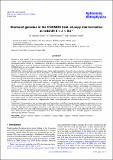Files in this item
Starburst galaxies in the COSMOS field : clumpy star-formation at redshift 0 < z <0.5
Item metadata
| dc.contributor.author | Hinojosa-Goñi, R. | |
| dc.contributor.author | Muñoz-Tuñón, C. | |
| dc.contributor.author | Méndez-Abreu, J. | |
| dc.date.accessioned | 2016-09-01T15:30:12Z | |
| dc.date.available | 2016-09-01T15:30:12Z | |
| dc.date.issued | 2016-08-11 | |
| dc.identifier | 245502234 | |
| dc.identifier | 81f44334-721e-4b85-9f63-075a458d16ac | |
| dc.identifier | 84982182207 | |
| dc.identifier | 000384722600029 | |
| dc.identifier.citation | Hinojosa-Goñi , R , Muñoz-Tuñón , C & Méndez-Abreu , J 2016 , ' Starburst galaxies in the COSMOS field : clumpy star-formation at redshift 0 < z <0.5 ' , Astronomy & Astrophysics , vol. 592 , A122 . https://doi.org/10.1051/0004-6361/201527066 | en |
| dc.identifier.issn | 0004-6361 | |
| dc.identifier.uri | https://hdl.handle.net/10023/9413 | |
| dc.description | This work has been funded by the Spanish MINECO, Grant ESTALLIDOS, AYA2013-47742-C4-2P and AYA2010-21887-C04-04. J.M.A. acknowledges support from the European Research Council Starting Grant SEDMorph (P.I. V. Wild). R.H.G. acknowledges the FPI grant from MINECO within ESTALLIDOS project. | en |
| dc.description.abstract | Context. At high redshift, starburst galaxies present irregular morphologies with 10-20% of their star formation occurring in giant clumps. These clumpy galaxies are considered the progenitors of local disk galaxies. To understand the properties of starbursts at intermediate and low redshift, it is fundamental to track their evolution and the possible link with the systems at higher z. Aims. We present an extensive, systematic, and multiband search and analysis of the starburst galaxies at redshift (0 <z <0.5) in the COSMOS field, as well as detailed characteristics of their star-forming clumps by using Hubble Space Telescope/Advance Camera for Surveys (HST/ACS) images. Methods. The starburst galaxies are identified using a tailor-made intermediate-band color excess selection, tracing the simultaneous presence of Hα and [OIII] emission lines in the galaxies. Our methodology uses previous information from the zCOSMOS spectral database to calibrate the color excess as a function of the equivalent width of both spectral lines. This technique allows us to identify 220 starburst galaxies at redshift 0 <z <0.5 using the SUBARU intermediate-band filters. Combining the high spatial resolution images from the HST/ACS with ground-based multi-wavelength photometry, we identify and parametrize the star-forming clumps in every galaxy. Their principal properties, sizes, masses, and star formation rates are provided. Results. The mass distribution of the starburst galaxies is remarkably similar to that of the whole galaxy sample with a peak around M/M⊙ ∼ 2 × 108 and only a few galaxies with M/M⊙ > 1010. We classify galaxies into three main types, depending on their HST morphology: single knot (Sknot), single star-forming knot plus diffuse light (Sknot+diffuse), and multiple star-forming knots (Mknots/clumpy) galaxy. We found a fraction of Mknots/clumpy galaxy fclumpy = 0.24 considering out total sample of starburst galaxies up to z ∼ 0.5. The individual star-forming knots in our sample follows the same L(Hα) vs. size scaling relation as local giant HII regions. However, they slightly differ from the one provided using samples at high redshift. This result highlights the importance of spatially resolving the star-forming regions for this kind of study. Star-forming clumps in the central regions of Mknots galaxies are more massive, and present higher star formation rates, than those in the outskirts. This trend is less clear when we consider either the mass surface density or surface star formation rate. Sknot galaxies do show properties similar to both dwarf elliptical and irregulars in the surface brightness (μ) versus Mhost diagram in the B-band, and to spheroidals and ellipticals in the μ versus Mhost diagram in the V-band. Conclusions. The properties of our star-forming knots in Sknot+diffuse and Mknots/clumpy galaxies support the predictions of recent numerical simulations claiming that they have been produced by violent disk instabilities. We suggest that the evolution of these knots means that large and massive clumps at the galaxy centers represent the end product of the coalescence of surviving smaller clumps from the outskirts. Our results support this mechanism and make it unlikely that mergers are the reason behind the observed starburst knots. Sknot galaxies might be transitional phases of the Blue Compact Dwarfs (BCD) class, with their properties consistent with spheroidal-like, but blue structures. | |
| dc.format.extent | 17 | |
| dc.format.extent | 3392875 | |
| dc.language.iso | eng | |
| dc.relation.ispartof | Astronomy & Astrophysics | en |
| dc.subject | Galaxies: bulges | en |
| dc.subject | Galaxies: evolution | en |
| dc.subject | Galaxies: formation | en |
| dc.subject | Galaxies: star formation | en |
| dc.subject | Galaxies: starburst | en |
| dc.subject | Galaxies: structure | en |
| dc.subject | Astronomy and Astrophysics | en |
| dc.subject | Space and Planetary Science | en |
| dc.subject | NDAS | en |
| dc.title | Starburst galaxies in the COSMOS field : clumpy star-formation at redshift 0 < z <0.5 | en |
| dc.type | Journal article | en |
| dc.contributor.sponsor | European Research Council | en |
| dc.contributor.institution | University of St Andrews. School of Physics and Astronomy | en |
| dc.identifier.doi | 10.1051/0004-6361/201527066 | |
| dc.description.status | Peer reviewed | en |
| dc.identifier.grantnumber | ERC-2012-StG-20111012 | en |
This item appears in the following Collection(s)
Items in the St Andrews Research Repository are protected by copyright, with all rights reserved, unless otherwise indicated.

